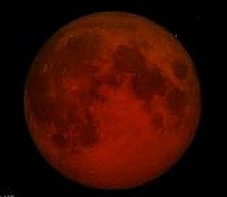
Look up the night of Jan 20 into morning of Jan 21. You won’t need a telescope or special glasses. It’s a “Supermoon,” “Wolfmoon,” “Bloodmoon. Ooh, it’s disappearing.
Eclipse Times
About midnight, CT, the full moon will have fully moved in its orbit between the earth and the sun. so it won’t be reflecting the sun’s rays. The total eclipse will last a long time – an hour.
The Adler Planetarium site lists Central Times for when it begins and happens as partial eclipse starting at 9:34 pm, and total eclipse from 10:41 to 11:43 pm, Jan. 20. Then watch as the moon emerges from behind the earth Jan.l 21.
In Universal Time the eclipse will last almost 3½ hours from the beginning of the partial phase at 3:34 UT until it ends at 6:51 UT. Totality lasts 63 minutes, from 4:41 to 5:44 UT.
Moon Names
So why “Supermoon?” “The moon’s orbit is not a perfect circle,” said Adler Director of Public Observing Michelle Nichols. “Sometimes it is closer to earth so it looks larger,” Nichols said. She noted that the closest it will come near the eclipse will be during the day of Jan. 21 at 1:59 p.m. She calls the appearance of the rising moon seeming to loom large, “an optical illusion.”
She suggested viewers use the thumb test. “Put an arm straight out and cover the moon with your thumb. Then, do it again later when the moon is over head. It will be the same size.”
“Bloodmoon” is a term describing the moon’s color during total eclipse. “Sometimes it looks brick red, sometimes grayish. The sunlight is reflecting at the edge of the earth. The earth has blotted out the blue of the sun so sometimes it could be reddish sometimes grayish. It also depends on how dusty the earth’s atmosphere is,” Nichols said.
“Wolfmoon” is a term for the first full moon of the year, acquired over the years similar to Harvest Moon and Hunter Moon. It also has other names such as Ice Moon according to Time and Date
which explains that people often named the full moons according to the seasons and the phenomena they associated with its time of year.
Where to Watch
View outside your abode. See it happening inside on a live stream at Time and Date Live which will be streaming the event on its site.
But to appreciate and enjoy the lunar eclipse with astronomers go over to the Adler for “Lunapalooza.” The outside observing part is free. Inside events, adults $12, children $8 (members free) include seeing the new Adler show “Imagine the Moon” which charts how people considered the moon over the centuries. Lunar eclipse
More Sky and Eclipse Information
These sites have charts, photos and lots of good astronomy information: Time and Date, Earth and Sky, Sky and Telescope and Space.
